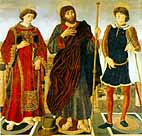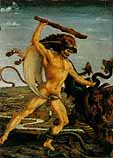Painters sculptors and goldsmiths
Antonio
(Florence 1431 - Rome 1498)
Piero
(Florence 1441 - Rome 1496)
They took their nickname from the trade of their father, who in fact sold
poultry. Antonio, the more gifted of the two, worked as a goldsmith for
Ghiberti, learned sculpture from Donatello and painting from Paolo Uccello. Piero studied painting under Andrea del Castagno and Paolo Uccello. Both were greatly
influenced by Alessio Baldovinetti (Florence 1425-99).
Famous for their studies in anatomy and the movement that they managed to instill
in their figures, the two brothers were soon well integrated in the culture of
their time, which expected the artist to have perfect knowledge of the human
body (in fact, not long afterwards Leonardo was to start carrying out his famous
dissections of dead bodies), in order to be able to portray them in a natural
way in three phases: movement, battle and tension.

Antonio and Piero
Altar-piece in S.Miniato
Antonio, the most versatile of the two, carried out the beautiful St.
Michael and the Dragon (Bardini Museum),
the two panels of the Labours of Hercules (Uffizi),
the last surviving paintings of a famous series, and the Profile of a
woman (Poldi Pezzoli Museum, Milan), identified by some as a portrait
of Simonetta Cattaneo Vespucci, who was the woman loved by Giuliano dei Medici,
killed in the Pazzi plot on May 23rd 1478 (and, according to some, also
loved by his brother, Lorenzo the Magnificent).
As a goldsmith he carried out the fine silver altar (1477-80), and the base of
the silver Cross in the Baptistery (both of them
today in the Museum del Opera del Duomo), while
as a sculptor he only worked in bronze or terracotta and never in marble: his
small bronze Hercules and Antaeus can be seen today at the Bargello. The particularly
fine and detailed method used by Antonio in his drawings was to encourage him
to experiment a new artistic technique, which certainly gives him even greater
importance, for he was to become one of the first engravers in history.
Piero, whose work tended to be more mediocre in colour and line, carried out
the Virtues (Uffizi), commissioned by the Guild of Merchants in 1469, the Coronation
of the Virgin (Church of Sant'Agostino in San Gimignano) and the portrait of
Giangaleazzo Maria Sforza (Uffizi).

Antonio
The
Labours of Hercules
The altarpiece in the Chapel of the Cardinal of Portugal (San
Miniato) and a few of the frescoes contained therein were works
of collaboration (the others are by Baldovinetti).
The two brothers were also to carry out the last two works of their lives together:
the burial monuments of Popes Sixtus IV (1484) and Innocent VIII (1492), the
first in the Vatican Grottos and the second in St. Peter's.

